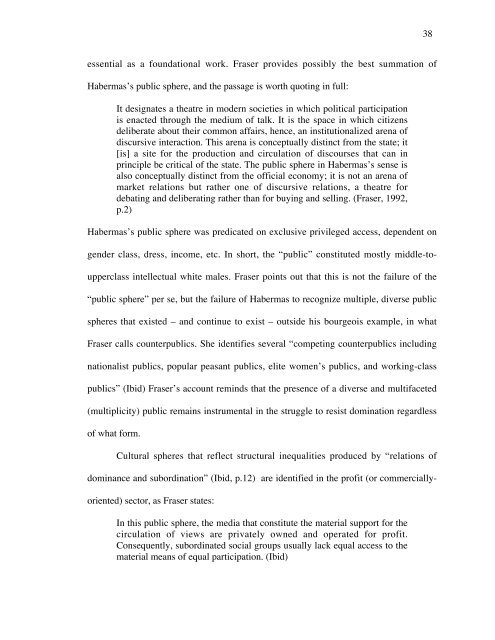The Spaces Between Grassroots Documentary ... - Ezra Winton
The Spaces Between Grassroots Documentary ... - Ezra Winton
The Spaces Between Grassroots Documentary ... - Ezra Winton
You also want an ePaper? Increase the reach of your titles
YUMPU automatically turns print PDFs into web optimized ePapers that Google loves.
essential as a foundational work. Fraser provides possibly the best summation of<br />
Habermas’s public sphere, and the passage is worth quoting in full:<br />
It designates a theatre in modern societies in which political participation<br />
is enacted through the medium of talk. It is the space in which citizens<br />
deliberate about their common affairs, hence, an institutionalized arena of<br />
discursive interaction. This arena is conceptually distinct from the state; it<br />
[is] a site for the production and circulation of discourses that can in<br />
principle be critical of the state. <strong>The</strong> public sphere in Habermas’s sense is<br />
also conceptually distinct from the official economy; it is not an arena of<br />
market relations but rather one of discursive relations, a theatre for<br />
debating and deliberating rather than for buying and selling. (Fraser, 1992,<br />
p.2)<br />
Habermas’s public sphere was predicated on exclusive privileged access, dependent on<br />
gender class, dress, income, etc. In short, the “public” constituted mostly middle-to-<br />
upperclass intellectual white males. Fraser points out that this is not the failure of the<br />
“public sphere” per se, but the failure of Habermas to recognize multiple, diverse public<br />
spheres that existed – and continue to exist – outside his bourgeois example, in what<br />
Fraser calls counterpublics. She identifies several “competing counterpublics including<br />
nationalist publics, popular peasant publics, elite women’s publics, and working-class<br />
publics” (Ibid) Fraser’s account reminds that the presence of a diverse and multifaceted<br />
(multiplicity) public remains instrumental in the struggle to resist domination regardless<br />
of what form.<br />
Cultural spheres that reflect structural inequalities produced by “relations of<br />
dominance and subordination” (Ibid, p.12) are identified in the profit (or commercially-<br />
oriented) sector, as Fraser states:<br />
In this public sphere, the media that constitute the material support for the<br />
circulation of views are privately owned and operated for profit.<br />
Consequently, subordinated social groups usually lack equal access to the<br />
material means of equal participation. (Ibid)<br />
38


